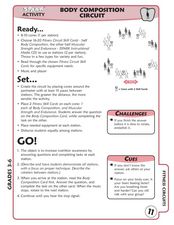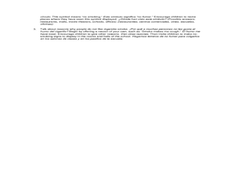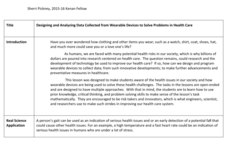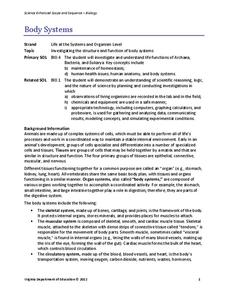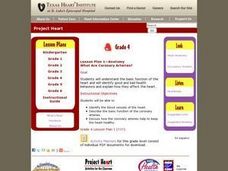Curated OER
Fancy a Walk?
Students examine the causes and effects of vertigo. In this personal health lesson, students watch 2 Red Cross video segments that feature a walkway in Spain. Students discuss vertigo and respond to discussion questions about the video...
Curated OER
The Dangers of Crack and Cocaine
In this health related worksheet, students discuss and analyze why people shouldn't use crack or cocaine and then complete a word search containing forty five words associated with the dangers of crack and cocaine.
Curated OER
Body Composition Circuit
Students work in groups to increase nutritional awareness. In this health and fitness lesson, students travel to various stations and complete the task on a body composition card.
PE Central
Fitness Advertisements
Exercise is good for your heart, your bones, your lungs, and your mood! Middle schoolers read more about the effects of regular exercise before creating their own posters that advertise the benefits of physical fitness.
Curated OER
Elastic Band Exercise
Seventh graders build muscle strength by using elastic bands. In this elastic band exercise lesson, 7th graders do various stretches and movements using an elastic band. Students go to different stations to do different exercises....
Curated OER
HOME SWEET HOME
Pupils create and implement a schedule of activities designed to help their parents improve their physical conditions.
Curated OER
Health and Nutrition
Students examine vocabulary words that deal with the parts of the body. They identify the body parts and organs associated with the five senses. They identify common illnesses, causes and treatments. They research various lifestyle...
Curated OER
Label the Respiratory System
In this labeling the respiratory system worksheet, learners observe an illustration of the respiratory system and label the heart, ribs, trachea, bronchioles, diaphragm, lung, and bronchus. Students write seven names.
American Heart Association
Meet the Calorie
What is a calorie and how does it work? How many calories do we consume in a typical day, and how many do our cells need to function well? Your learners will answer these questions and more using a worksheet, which includes informational...
We Can!
We Can! Screen Time Chart
Screens are everywhere these days, from televisions and video games to cell phones and computers. Raise awareness of excessive screen time by helping your learners track how much time they each accumulate on a daily basis looking at...
Curated OER
X-rays
Students examine chest x-rays of adults and students and learn what an X-ray illustrates. They also explore the limitations to X-ray technology for use in diagnosing heart and lung ailments.
Curated OER
What's For Breakfast, Lunch, and Dinner?
Students identify breakfast, lunch, and dinner foods. For this dietary awareness lesson, students draw pictures of their favorite foods and arrange the complete pictures on a bulletin board. Students discuss the details of their pictures...
Curated OER
Cardiovascular Disease
In this health worksheet, middle schoolers find the words that are related to cardiovascular disease and the answers are found at the bottom of the page.
Curated OER
Risky Business worksheet
In this health worksheet, pupils interview friends and family to see what risky health factors they have. Students interview 5 people about 6 risky factors each.
Curated OER
What's Ponytail's Big News?
Learners discuss reasons to not smoke. In this anti-smoking lesson, students listen to a story where the character Ponytail the pony doesn't smoke and is thus able to engage in physical activities. They create Ponytail's pinwheel with a...
Texas Heart Institute
Exercise: What Kinds of Activities Are Best?
What happens in the muscles during anaerobic and aerobic exercise, and how does this affect the heart and our overall health? A cross-curricular instructional activity that introduces learners to the lifelong benefits of exercise,...
Kenan Fellows
Designing and Analyzing Data Collected from Wearable Devices to Solve Problems in Health Care
Wearable devices have become more the norm than the exception. Learners analyze data from a sample device with a regression analysis in a helpful hands-on lesson. Their focus is to determine if there is a connection between temperature...
Baylor College
What is Blood Pressure?
Find out how we describe the force created by the blood against the walls of the vessels in a heart-pumping lesson plan! As part of a unit on the heart and circulatory system, cardiology kids use a blood pressure monitor to find their...
Curated OER
Black Tiger Academy Martial Arts Fitness Unit – Lesson 3
“A good exercise for the heart is to bend down and help another up.” Black Tiger Academy’s martial arts lesson three of 20 focuses on cardiovascular exercise and activities that get that heart pumping. There are quite a few activities to...
Curated OER
Santé
How is your health? Intermediate Francophones read a two-paragraph text about healthy eating and the problems associated with those who do not make healthy choices. Two exercises follow the reading passage: the first is a short...
Virginia Department of Education
Body Systems
The human body is an amazing thing! Explore the body with your high school class as they investigate each system in detail. They learn components of each organ system and disease processes that can negatively affect general health and...
Curated OER
What's in a Number? Analyzing Smoking Statistics
Sixth and seventh graders analyze smoking statistics. In this health lesson, learners look at the percentage of people who smoke from each race group. They create a bar graph and circle graph that displays this information.
Curated OER
Anatomy - What Are Coronary Arteries?
Fourth graders explore the basic function of the heart, identify blood vessels and coronary arteries. They identify good and bad health behaviors and discuss how these behaviors affect the heart. Students explore how the coronary...
Curated OER
Hearbeat
Third graders pair up and listen to each others heartbeat. They run in place for one minute and then listen again and calculate the beats per minute resting and after activity. They switch and repeat the activity.




